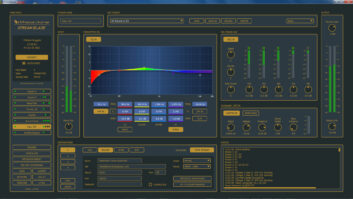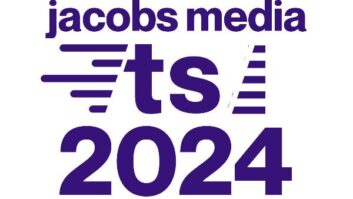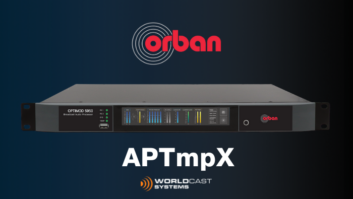NEW YORK The Arbitron Portable People Meter is coming to New York, with encoder installations to start this month. Arbitron representatives recently spoke with New York market engineers at a meeting of the Society of Broadcast Engineers, Chapter 15, to discuss installation and technical issues, plus general questions regarding the PPM.
In preparation for the meeting, Arbitron shipped an encoding package to my office at WOR Radio, and I installed the PPM encoder on one of WOR’s backup STL paths. WOR was running active PPM encoding for the week and during the SBE meeting.
When the encoder was installed, we sent an e-mail blast to the membership of SBE 15 asking engineers to tune in WOR at some point over the time between installation and the SBE meeting to see if anyone could hear the encoding on the air.
The encoding package includes the Arbitron PPM encoder or encoders and a monitor so that you can tell if your encoding is working. One of the concerns of New York engineers was that we might be limited to one encoder per station.
Is this thing on?
Most of us have several completely redundant paths to deliver audio from studio to transmitter, with separate paths at the studio, then separate STL paths to the transmitter, and even having separate paths between the STLs and the transmitters. Also, some of us have more than one transmitter facility.
Arbitron will fully outfit each station as required. If you need five encoders and want one on the shelf as a spare, you will get five encoders and one to stick on the shelf. If you replace ads on your Internet feed, you will get a separate encoder for your Internet feed.
The encoder is a rack-mount box, one RU high. There are two versions available, AES and analog.
WOR installed the analog PPM encoder on a backup path. Installation was literally a five-minute job.
I also ran a coax from the encoder’s time sync input to one of our GPS master clocks so the encoder would be time-locked. If a station does not have a time base, the internal clock on the encoder has a specified accuracy of 1.7 minutes per calendar year.
Additionally, the time sync input will sync to almost every time standard found in broadcast facilities.
That was the installation of the encoder. Quite boring. There is nothing to adjust, and it is intended to go between your pre-processing and the main processing of the station. The encoder is expecting a nominal +4 audio input. Once it sees audio, it will start encoding.
The PPM monitor is also a 1 RU box. It takes audio in from an off-air radio. I fed it from the modified HD-R car radio we use to monitor. The monitor will provide a contact closure to trigger an alarm of your choice.
There is also a big LED on the front that is normally green, but will shine bright red if there is a problem. After all, encoding the PPM data will be just as important as being on the air!
I think everyone knows how Arbitron gathers listening information right now. A person is asked to write his or her listening habits down in a diary for one week, and then send the diary back to Arbitron.
Listening, shopping habits
With PPM, everyone in a household will be given a meter to carry. The commitment from individuals participating in the program will be two years.
Each meter has a docking station. All docking stations communicate with a central hub/modem through the house wiring. Right now, all participating households have wired phone lines. Arbitron is working on a cellular (wireless) modem for those who do not have wireline phones.
The modem phones home nightly to send data to Arbitron. What happens if a participant forgets to dock the meter at night? The unit has about a capacity of about one to two weeks, so you could theoretically go on vacation and dock it when you return. Which brings up another interesting point. If I have a PPM meter and go on vacation to Phoenix to see my mom, all the information I upload to Arbitron will be on the Phoenix area.
They did not have an answer for us at the meeting as to how this data would be interpreted and/or reported.
In addition to radio stations, television stations can be encoded; commercials can and are being encoded, as are network programs. Additionally, it is not inconceivable that venues such as the PA system at Giants Stadium, the local mall and all its individual shops can be encoded.
If Arbitron were to encode the PA system in Giants Stadium, the PPM would hear the encoding when the participant attended a Giants game. Attend every game or a majority of games over the course of the season, and it would be assumed that this person has season tickets.
If Arbitron makes the data available, you will literally be able to see that, for example, the typical WOR listener has season tickets to Giants games, frequents the Garden State Plaza mall, shops frequently at Neiman Marcus and Macys at Garden State Plaza, and has lunch in TGI Fridays. This information could be a boon for sales departments, but can also be very scary in its detail.
By encoding the PA systems of a venue, whether it be the mall, a store, Starbucks, Giants Stadium or Joe’s X-Rated Theater and Toy Store, if there is encoded audio where the person and his/her PPM is, the PPM will report it.
If you’re someplace that simply has a radio on, it will report what station was on at the time of your visit, but not indicate you were in the smoke shop. If Macy’s encoded its PA Muzak system, it would know you went to Macy’s. If each Macy’s were to have encoding specific to that location, Arbitron could tell which Macy’s you were in.
The PPM is also motion-sensitive and it is intended to be worn. If you take the PPM off and simply set it on a counter, and say that WOR was on the kitchen radio, our ratings would be weighted differently than if the person was wearing the PPM in the kitchen. This is to keep people from simply placing the PPM near a radio, turning the radio on and leaving the meter there all day.
Inaudible
During the presentation by Arbitron Broadcast Engineer, Encoding Operations Dan Hunt (who’s also an SBE member), we had placed a cheap, lousy AM radio on the windowsill of the WOR conference room. Hunt wore a Portable People Meter during his presentation.
He then docked the unit and displayed the data on his laptop computer. There it was right up on the screen. The PPM can “hear” fairly low levels of audio, and part of the docking procedure is a brief 2 kHz tone that checks the meter to make sure it’s not going deaf.
The PPM encoding works on the principal of psychoacoustic masking, which says that the human ear cannot resolve a frequency immediately adjacent to another frequency that is dominant. The encoder looks at the incoming audio, and then places the data appropriately so that a human, at least, does not hear it.
The data is in the 1 kHz to 3 kHz area, and Arbitron can check its operation by a station engineer holding the phone up to a radio speaker. Latency through the encoder is practically zero, as the audio is simply passed through a mixing stage.
The data is mixed in after the fact. Not one member of SBE 15 was able to hear the encoding on the air. I also did not see any changes in the characteristics of our processing or modulation.
Life in this business is about to become different once again with the arrival of the Portable People Meter. The first New York book to include the PPM data will be in the fall. I will report on the system again once everyone in the city is running it.
Radio World welcomes your experiences with new technologies including electronic measurement systems. Write to [email protected].












